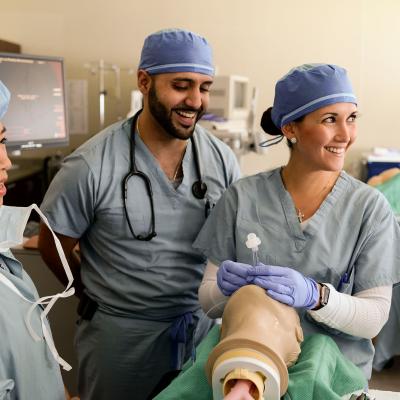- AdventHealth University

The vital role of nurses is undeniable. Nurses not only provide critical care to patients in need, but they also serve as agents of change, advocating for patients and promoting improvements across health systems.
Well over 3 million nurses treat, support, and educate patients about critical health information, according to the U.S. Bureau of Labor Statistics (BLS). In the coming years, the BLS projects this number to grow, estimating that by 2028, the nation will require an additional 371,500 nurses to meet the needs of an aging population.
Additionally, as communities struggle with pandemics like COVID-19, they often depend on nurses for information, care, and emotional support. They are wise to do so—nurses of all types contribute in key ways to pandemic responses.
The U.S. Centers for Disease Control and Prevention (CDC) explains that to effectively manage an emerging pandemic, responders must quickly recognize it. As case numbers of a disease increase, or clusters emerge, health professionals must immediately identify them.
Because nurses work on the front lines. They stand in an excellent position to rapidly identify communicable diseases and spot infectious pathogens early.
Nurses in Public and Community Health Clinics
Public and community health centers give marginalized communities access to healthcare. People with limited funds, lack of insurance, or language barriers rely on these clinics to deliver their primary care.
The nurses working in public and community health clinics deliver care that:
- Prevents diseases
- Promotes and maintains health
- Educates patients about their health
- Diagnoses and treats illnesses and injuries
This often involves offering services such as blood pressure and cholesterol screenings, diabetes screening, diet counseling, immunizations and vaccines, well visits, family planning, and developmental screening for children. Additionally, these nurses address chronic illnesses, such as diabetes, or acute illnesses, such as the flu and cold viruses.
Community Health Nurse Duties During Disease Outbreaks
During a disease outbreak, nurses working in public and community health clinics typically carry on with their regular duties. However, the way they do so may change in efforts to limit disease spread and to protect their health and the health of their patients.
For example, during a highly infectious pandemic such as COVID-19, nurses may:
- Screen patients for symptoms over the phone
- Conduct appointments, such as behavioral health appointments, remotely
- Take on extra duties including educating patients about self‐isolation and quarantine via hotlines
- Help interpret the changing and developing recommendations and information from the CDC
Prevention is the ideal response to a potential global pandemic. Key to prevention is early recognition. Nurses in community or public health clinics who have regular and ongoing connections to community members are positioned to recognize symptoms of new or reemerging infectious diseases.
Further, nurses help clinics track symptoms. They can also refer patients and educate them about disease transmission and how to protect themselves and others. By teaching patients about social distancing, proper hand-washing, and other sanitation practices, nurses can help stop the spread of an infectious disease.
Additionally, nursing leaders can work to develop early reporting networks that keep public health officials and public health organizations, such as local and state health departments, informed so they can take early preventive measures and communicate with the public.
Nurses in Emergency Rooms
Emergency room (ER) nurses often treat patients with life-threatening health conditions. By their very nature, emergency departments deal with the most urgent health problems, delivering care to car accident victims, gunshot victims, and people in cardiac arrest.
The patients ER nurses treat can present with almost any type of urgent health problem, from acute abdominal pain to a fractured bone. This requires fast action on the part of nurses to identify what’s wrong and help stabilize the patient.
Triage assessment, a rapid assessment of patients entering an ER, plays a key role in ERs. The process involves looking for signs of injury, responsiveness, and expressions of fear or anxiety, among other signs.
Specifically, triage includes the following:
- Determining if patients suffer from blocked or impaired airways
- Assessing if breathing is labored
- Examining circulation by checking for bleeding and the speed and rhythm of the patient’s pulse
- Assessing the patient’s level of consciousness, pain, and muscle strength
- Determining the patient’s exposure to harmful materials or environments, such as extreme cold or heat
Patients in an ER come from all age groups and backgrounds. ER nurses can care for babies, older people, those with serious mental health problems, and people under the influence of controlled substances.
ER nurses prioritize the seriousness of conditions, stabilize immediate symptoms, and move patients to the next level of treatment or prepare them to return home after treatment.
ER Nurse Duties During a Disease Outbreak
The role of nurses in ERs also involves a front-line response to epidemics or pandemics.
ER nurses typically offer initial care to patients who may have the infectious disease. They start by assessing symptoms. When patients arrive at ERs in ambulances, nurses consult with paramedics about the patients’ vital signs and immediate needs.
Depending on protocols established by their departments, ER nurses may administer tests and treatments for the infectious disease in question. This could include providing oxygen or medications that stabilize the patient.
During highly infectious disease outbreaks like the COVID-19 pandemic, hospitals may create separate units for those infected. ER nurses quarantine patients who test positive or show symptoms of the disease as quickly as possible.
ER nurses also play a critical role in carrying out infectious disease prevention. By taking additional precautions that help prevent the disease from spreading, such as proper use of personal protective equipment (PPE) and social distancing measures, they can help prevent the disease from spreading.
Nurses in Intensive Care Units
Intensive care nurses treat the most vulnerable and sick patients in a hospital or clinic. In critical care units, patients aren’t always expected to survive. Intensive care unit (ICU) nurses apply specialized knowledge to understand whether patients are recovering or struggling to survive.
By adjusting fluids, medications, or therapeutic devices, such as ventilators, ICU nurses strive to avoid complications and stabilize patients as they recover from accidents, diseases, or surgeries.
ICU patients often have multiple doctors and other medical professionals attending to their various needs. ICU nurses help coordinate care between these different staff members. They also mediate between doctors and patients’ families regarding care options.
Critical care units depend on technology and equipment to address complex health issues. Often ICU patients can’t communicate, so nurses rely on machines and monitoring devices to collect critical information. For example, ICU nurses may need to manipulate pulse oximeters to monitor the oxygen in a patient’s bloodstream or keep track of a patient’s heart activity by reading electrocardiographs.
Critical Care Nurse Duties During a Disease Outbreak
Infectious disease outbreaks can overwhelm ICU units. With greater numbers of patients needing intensive care, ICU staff may find themselves seriously strained.
Critical care nurses, then, are challenged to make very difficult decisions, in collaboration with other medical staff, about how to use limited resources.
ICU nurses contribute to decisions regarding:
- Which patients can be discharged to other units
- How to free up ventilators using other treatment techniques
- Which patients assessed as unlikely to recover should be taken off ventilators, so they can be used for patients more likely to recover
In addition to having to make difficult decisions during disease outbreaks, ICU nurses can face long hours, physical discomfort from extended use of masks and other PPE, and anxiety about both their patients’ health and their own.
During the COVID-19 pandemic, many ICU nurses have found themselves in harrowing circumstances. With no visitors allowed in hospitals, ICU nurses have comforted patients in their final hours of life. Using tablets and other devices, ICU nurses have contacted the loved ones of patients, so they could say their final goodbyes.
Despite these distressing experiences, during disease outbreaks, ICU nurses can deliver the bedside care to patients that ultimately leads to their recovery.
Nurses in Nursing Homes
The role of nurses in nursing homes spans a variety of duties. These nurses work in both supervisorial and clinical capacities to ensure the well-being of their older patients.
Nursing home patients receive care from several medical professionals, including nursing assistants and doctors. Nurses often supervise assistants and aides to ensure that patients receive quality care.
This can involve designating jobs and monitoring the staff’s activities. In this position, nurses also communicate with facility doctors regarding patients’ conditions.
Other duties of nursing home nurses include the following:
- Monitoring patients’ hygiene
- Administering medication
- Checking patients’ blood pressure, temperatures, and heart rates
- Monitoring and treating their patients’ health conditions, such as Alzheimer’s disease and diabetes
- Initiating treatment plans
In general, nursing home nurses look after the overall health of their patients and make sure that they get the care they need. They also interact with patients’ families and keep them informed about any health changes or additional patient needs.
Nursing Home Nurse Duties During a Disease Outbreak
Infectious diseases can pose an especially serious threat to older patients whose health and age often make them more susceptible.
For this reason, during a disease outbreak like COVID-19, nursing home nurses must take extra precautions to protect their patients from infection and observe strict rules to prevent the spread of disease in the facility.
For example, nurses disinfect surfaces that receive a lot of traffic. They also track patients for symptoms of the disease. In this way, if someone becomes infected, nurses can take immediate action to quarantine them. Nursing home nurses must also ensure that all staff members effectively use PPE, such as masks and gloves.
Nursing homes often receive patients returning from hospital stays. During a disease outbreak, this demands ingenuity on the part of nurses who must care for a potentially contagious patient alongside a healthy one.
In such situations, nurses may devise strategies to ensure that these returning patients remain separate from the rest of the facility’s population. When possible, they’ll assign more staff to shifts to accommodate this.
Additionally, during a disease outbreak, nursing homes may close their facilities to outside visitors. This limits patient social interaction and can increase their feelings of loneliness and depression. As a result, nurses will have the added responsibility of providing emotional support to patients.
Telehealth Nursing
Telehealth nursing uses technology for remote healthcare. Nurses use webcams, the internet, Voice over IP (VoIP), and phones to conduct a telehealth session from a hospital, a doctor’s office, or even from home. Telehealth nursing serves as an extension of an existing medical practice, hospital, or health clinic.
For example, a nurse working at an obstetrician’s office may take after-hours calls from expectant mothers about possible signs of labor. On the other hand, ER nurses may use telehealth nursing to explain to a patient how to treat a minor wound.
Other health services telehealth nursing can provide include the following:
- Explaining how to treat minor illnesses at home
- Discussing lab results
- Explaining treatment options
- Directing patients to an ER
- Helping patients get refills on medications
During a telehealth visit, nurses ask patients questions about their health and then interpret the information. After reviewing symptoms, nurses assess the urgency level and care required to address a patient’s needs.
Telehealth nurses respond to a variety of health concerns using evidence-based guidelines. This approach can improve access to healthcare and reduce the on-call hours of healthcare providers. It can also lower the number of unnecessary ER visits.
Telehealth Nursing During a Disease Outbreak
The remote nature of telehealth nursing can make it an excellent resource during a disease outbreak. Since it doesn’t require close contact, it can lower the risk of spreading illness while still allowing patients to get the health services they need.
For example, a woman with mild flu symptoms who meets the requirement for self-care at home can receive instructions about medication, rest, and signs to look out for, without leaving home. In this way, the patient doesn’t risk exposure to disease while being immunocompromised, and is still able to get care without exposing others.
Telehealth nurses remotely assess and prioritize patients during disease outbreaks and deliver key information to them quickly.
Additionally, older people, people with autoimmune disorders, or any person in a high-risk category for serious infection can stay at home but still get routine care without risking exposure.
Discover the Benefits of Earning a Master of Science in Nursing
The role of nurses ranges from using a complex array of life support machines to developing vital reporting networks that help track symptoms during disease outbreaks. Plus, nurses play a critical part in patient recovery and disease management and prevention.
With the right training, nurses can find rewarding work in diverse positions. AdventHealth University Online offers an advanced nursing degree program that builds leadership skills and prepares nurses to shape nursing practice and innovate solutions to some of healthcare’s greatest challenges.
Explore how earning a Master of Science in Nursing from AdventHealth University Online allows nurses to advance their careers and become leaders in the field.
Recommended Readings
Acute Care Nurse Practitioner vs. Family Nurse Practitioner: Choosing a Career for Care
Career Spotlight: How to Become a Chief Nursing Officer
Career Spotlight: How to Become a Public Health Nurse Practitioner
Sources:
American Academy of Family Physicians, Primary Care
American Nurse Journal, “What’s a Rapid Triage Assessment?”
American Nurses Association, “Public Health Nursing”
Assisted Living Today, The Role of Nurses in a Nursing Home
Callen-Lorde, “Responding to COVID-19”
Centre for Evidence-Based Medicine, “How Can Pandemic Spreads Be Contained in Care Homes?
HealthCare.gov, Preventive Care Benefits for Adults
HealthLeaders, “Covid-19 Is Affecting Critical Care Nurses. What Nurse Leaders Need to Know”
Houston Chronicle, “What Is an RN’s Role in the ER?”
Journal of Healthcare Communications, “Communicating the Changing Role of a Nurse in an Epidemic: The Example of the MERS-CoV Outbreak in Saudi Arabia”
Journal of Telemedicine and Telecare, “Telehealth for Global Emergencies: Implications for Coronavirus Disease 2019 (COVID-19)”
Life in the Fast Lane, “ICU Response to a Pandemic”
National Association of Community Health Centers, What Is a Community Health Center?
Nursing Outlook, “Expanding Nursing’s Role in Responding to Global Pandemics 5/14/2018”
Nursing2020, “Telehealth Nursing: More Than Just a Phone Call”
Public Health Nursing, “A Call to Action for Public Health Nurses During the COVID‐19 Pandemic”
Scientific American, “Global Infections by the Numbers”
Scientific American, “Nurses Are Playing a Crucial Role in this Pandemic—as Always”
Sigma, Global Advisory Panel on the Future of Nursing & Midwifery
The Atlantic, “The Reality Is, It’s Incredibly Hard”
U.S. Bureau of Labor Statistics, Registered Nurses
World Economic Forum, “Coronavirus Isn’t an Outlier, It’s Part of Our Interconnected Viral Age”


